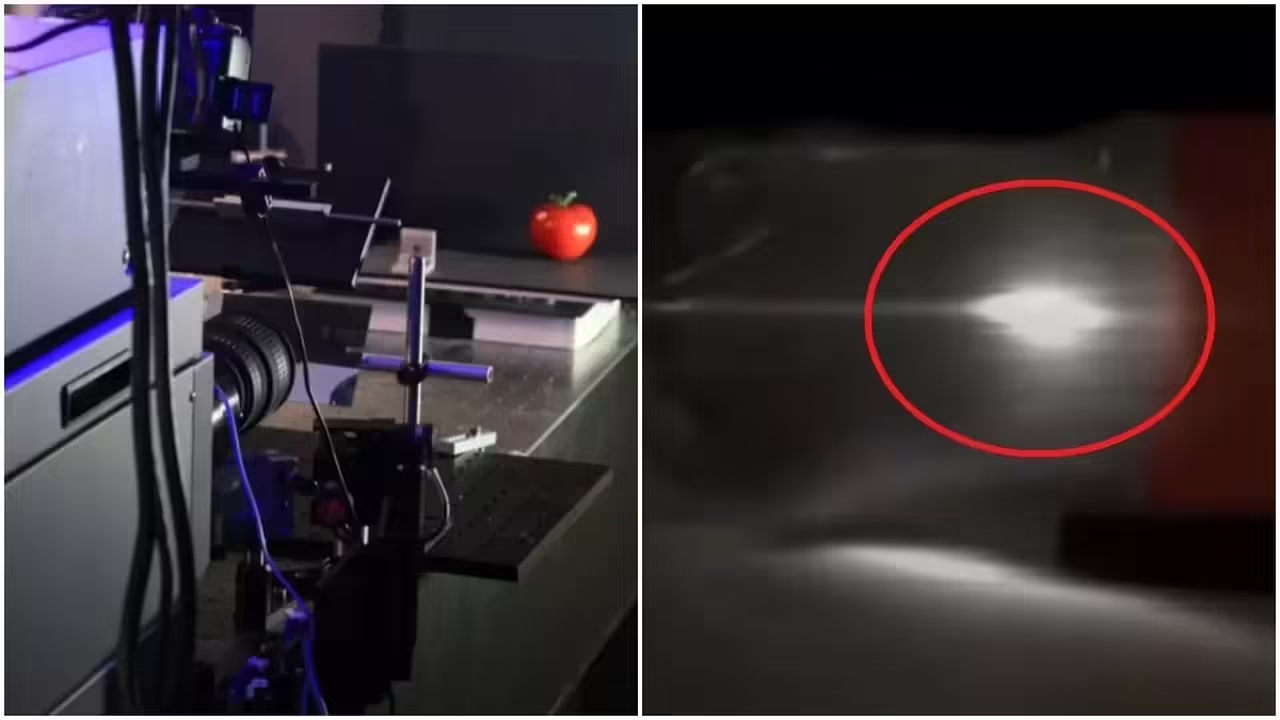
In the fascinating world of technology, high-speed cameras have revolutionized the way we observe and understand rapid phenomena. Among these, a camera stands out with the ability to capture a trillion frames per second. This extraordinary advancement has been made possible through the combined efforts of physicists, engineers, and imaging scientists, who have developed technologies capable of capturing events at unprecedented speeds.
How Does It Work?
The trillion frames per second camera uses a technique known as “compressed ultrafast photography.” Instead of capturing images sequentially like traditional cameras, this technology relies on capturing simultaneous images that are then decompressed and reconstructed to form an accurate temporal sequence.
The heart of this technology is a system of sensors and an advanced algorithm that allows the recording and processing of large volumes of data in a fraction of a second. This system can detect minute changes in light intensity, enabling it to capture details that would otherwise be invisible.
Unique Capabilities
The ability to capture a trillion frames per second allows scientists to observe extremely rapid phenomena with unprecedented clarity. Some of the most notable uses include:
Study of Light and Motion: The speed of light, though fast, can be captured and analyzed. This capability is crucial for better understanding optical phenomena and improving light-based technologies such as optical communications and laser systems.
Observation of Chemical Reactions: Chemical reactions often occur on extremely rapid time scales. This camera allows scientists to see how these reactions unfold in real time, providing valuable information for chemistry and molecular biology.
Impact and Explosion Analysis: In engineering and safety, understanding how impacts and explosions occur is fundamental. Capturing these events at high speed allows for the development of more resistant materials and improved safety measures.
Biomedical Research: In medicine, the ability to observe rapid biological processes, such as cellular activity and nerve impulse propagation, opens new frontiers in research and treatment of diseases.
Importance of Capturing a Trillion Frames per Second
Capturing a trillion frames per second is not just a technical feat but has profound implications for various fields of science and technology. The ability to see and analyze rapid phenomena in such detail allows for:
Innovation in Future Technologies: Many emerging technologies, such as quantum computing and nanotechnology, depend on understanding processes that occur at extreme speeds. This camera provides a crucial tool for research in these fields.
Advances in Fundamental Science: The ability to observe phenomena at this time scale can lead to new fundamental discoveries in physics and chemistry, revealing aspects of the universe that were previously inaccessible.
Improvements in Safety and Health: Detailed understanding of how impacts, explosions, and rapid biological processes occur can lead to significant improvements in industrial safety and medical treatments.
Principle of Operation of the Trillion Frames per Second Camera
Technical Explanation of How the Camera Works
The operation of a camera capable of capturing a trillion frames per second is based on advanced principles of optics, electronics, and image processing. Here is the technical process:
Compressed Ultrafast Photography: Unlike conventional cameras that capture images sequentially, this camera uses a technique called “compressed ultrafast photography” (CUP). This method allows for the simultaneous recording of multiple images and their storage in a compressed format.
Space-Time Modulation: The camera employs a spatial light modulator (SLM) to encode spatial and temporal information into a single image. This device modifies the path and properties of incident light, allowing the encoding of temporal information into spatial patterns.
Fast Photodetection Sensor: The modulated light is captured by an extremely fast photodetection sensor, such as a CMOS camera sensor or a charge-coupled device (CCD) detector with special capabilities to handle ultrafast frame rates.
Computational Reconstruction: The captured data are processed by advanced algorithms that decompress and reconstruct the images into a temporal sequence. This processing includes solving complex mathematical problems to decode the compressed information and produce a coherent and precise series of frames.
Key Technologies and Components Used
To achieve the feat of capturing a trillion frames per second, the camera employs several advanced technologies and components. Some of the most important include:
Spatial Light Modulator (SLM):
Function: Enables spatial encoding of temporal information. Description: A device that controls the phase, amplitude, or polarization of light at each point on its surface. It is crucial for the compression technique used. High-Speed Sensors:
Types: Specially designed CMOS or CCD sensors for high frame rates. Characteristics: Ability to handle and process electrical signals at extremely high speeds, with high sensitivity and low latency. Pulsed Light Sources:
Function: Provide adequate illumination for capturing ultrafast events. Description: Ultrashort pulse lasers that emit flashes of light with durations on the order of femtoseconds (10^-15 seconds). These pulses allow for the illumination of rapid scenes without blur. Advanced Optical Systems:
Function: Focus and direct light towards the sensor and modulator. Description: Lenses, mirrors, and other optical components designed to minimize aberrations and maximize capture precision. Image Processing Algorithms:
Function: Decode and reconstruct compressed images into a coherent sequence. Description: Software that uses data compression techniques, temporal interpolation, and image reconstruction to convert raw data into usable frames. Cooling and Power Management Systems:
Function: Maintain the stability and performance of electronic components. Description: Advanced cooling systems and efficient power management to dissipate the heat generated by high-speed data processing. Process Summary
The complete process of capture with this ultrafast camera can be summarized in the following steps:
Illumination of the Scene: The pulsed light source illuminates the ultrafast event. Light Modulation: The light reflected or transmitted by the scene is modulated spatially and temporally by the SLM. Capture of Modulated Light: The high-speed sensor captures the modulated light, recording the compressed information. Data Processing: The captured data are processed by reconstruction algorithms that decode the information and generate a sequence of frames.
Comparison with Traditional and Other High-Speed Cameras
Traditional Cameras
Traditional cameras, such as those used in everyday photography, generally capture between 24 and 60 frames per second (fps). These cameras are suitable for common applications like photography and videography but cannot capture rapid events in sufficient detail.
Capture Speed: 24-60 fps. Applications: Everyday photography and videography, video conferencing, etc. Limitations: Inability to capture rapid events, blur in fast movements. Conventional High-Speed Cameras
High-speed cameras used in scientific and industrial research can capture from several thousand to a million frames per second.
Capture Speed: 1,000 – 1,000,000 fps. Applications: Analysis of rapid movements, ballistic studies, fluid dynamics research, etc. Limitations: Although these cameras capture faster events, they still have limitations in temporal resolution and the ability to handle data at extremely high speeds. Trillion Frames per Second Camera
This camera represents a quantum leap in ultrafast capture capability.
Capture Speed: 1,000,000,000 fps. Applications: Study of light and motion, observation of ultrafast chemical reactions, analysis of explosions and impacts, biomedical research, etc. Advantages: Capture of phenomena at extremely short time scales, allowing unprecedented temporal resolution. Specific Innovations that Make This Capture Speed Possible
To achieve the incredible speed of a trillion frames per second, several key technological innovations have been developed:
Compressed Ultrafast Photography (CUP)
The CUP technique is fundamental for capturing images at extreme speeds. Instead of taking images sequentially, this technique allows the simultaneous capture of multiple compressed images.
Innovation: Simultaneous data capture and temporal information compression into a single frame. Benefit: Allows the reconstruction of ultrafast temporal sequences without the need for real-time storage and processing of large volumes of data. Spatial Light Modulator (SLM)
The SLM plays a crucial role in encoding spatial and temporal information.
Innovation: Ability to modify light properties at each point on its surface, allowing spatial encoding of temporal information. Benefit: Provides an efficient way to map temporal information into spatial patterns that can be captured by sensors. High-Speed Photodetection Sensors
High-speed sensors, such as specialized CMOS or CCD sensors, are essential for capturing data at extreme speeds.
Innovation: Sensors capable of handling and processing electrical signals at ultrafast frame rates. Benefit: High sensitivity and low latency in data capture, allowing the recording of rapid events with great precision. Ultrashort Pulsed Light Sources
Light sources, such as ultrashort pulse lasers, are vital for illuminating ultrafast scenes.
Innovation: Emission of light flashes of extremely short durations, on the order of femtoseconds. Benefit: Allows for adequate illumination of rapid events without blur, improving the clarity and precision of captures. Advanced Image Processing Algorithms
Processing the captured data requires sophisticated algorithms to decompress and reconstruct the images.
Innovation: Algorithms that use data compression, temporal interpolation, and image reconstruction techniques. Benefit: Ability to transform compressed data into coherent and detailed temporal sequences, enabling precise analysis of rapid phenomena. Impact on Science and Technology
The combination of these innovations has not only made it possible to capture a trillion frames per second but has also opened new possibilities in multiple fields:
Physics and Optics: Detailed study of optical and dynamic phenomena, such as light propagation and shock waves. Chemistry and Biology: Observation of ultrafast chemical reactions and biological processes, providing valuable information for molecular and medical science. Engineering and Safety: Analysis of explosions, impacts, and structural failures, improving designs and safety measures. Technology and Computing: Development of new technologies in telecommunications, quantum computing, and ultrafast electronics.
Practical Applications of the Trillion Frames per Second Camera
Uses in Scientific Research and Technology
The ability to capture a trillion frames per second opens up a vast field of applications in various scientific and technological areas. This ultrafast camera allows for the observation and analysis of extremely rapid phenomena, providing detailed and precise information that was previously inaccessible with earlier technologies.
Applications in Various Areas
Biomedical Research:
Observation of Cellular Processes: Enables the study of rapid biological processes, such as cell division and nerve impulse propagation, with unprecedented temporal resolution. Analysis of Biochemical Reactions: Helps to better understand rapid biochemical interactions, such as enzymatic reactions, which can lead to the development of new drugs and therapies. Medical Imaging:
Better Diagnosis: The ability to capture ultrafast images improves diagnostic imaging techniques, such as fluoroscopy and functional magnetic resonance imaging (fMRI), by providing clearer and more detailed images of rapid processes in the human body. Physics
Study of Optical Phenomena:
Light Propagation: Allows for observing how light propagates in different media, improving our understanding of optics and photonics. Light-Matter Interactions: Helps study the rapid interactions between light and matter, essential for the development of new optical and photonic technologies. Fluid Dynamics:
Turbulence Analysis: Capturing fluid movements at high speed allows for detailed study of turbulences, fundamental in aerodynamics and hydrodynamics. Shock Wave Study: Facilitates the analysis of shock waves in gases and liquids, relevant for applications in engineering and high-energy physics. Engineering
Impact and Explosion Testing:
Safety and Material Design: Allows for detailed analysis of how materials respond to impacts and explosions, improving structural designs and safety measures. Development of New Materials: Helps in creating more resistant and safer materials, essential for construction, automotive, and aerospace industries. Electronics Research:
High-Speed Circuit Analysis: Enables the study of the dynamics of fast electronic circuits, crucial for developing high-speed and low-latency devices. Semiconductor Development: Helps improve the design and performance of semiconductors, fundamental for modern electronics and computing. Chemistry
Ultrafast Chemical Reactions:
Reaction Kinetics: Allows for observing the intermediate stages of chemical reactions, providing detailed information on reaction kinetics. Catalyst Development: Helps design more efficient catalysts by allowing the study of catalytic processes in real-time. Photocatalysis and Photochemistry:
Light-Molecule Interactions: Facilitates the study of how molecules react to light, relevant for developing technologies based on photochemistry, such as photocatalysis and solar energy. Other Areas
Safety and Defense:
Ballistic Analysis: Allows for detailed study of projectile trajectories and effects, improving defense and security technologies. Explosive Detection and Deactivation: Helps develop advanced techniques for detecting and deactivating explosives by analyzing explosion dynamics in detail. Telecommunications:
Optical Network Development: Facilitates the study of data transmission through optical fibers, improving high-speed communication technologies. Quantum Technologies: Helps in researching rapid quantum phenomena, essential for developing quantum computing and secure communications.







